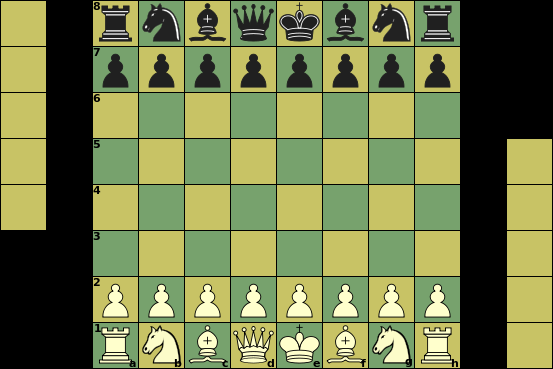Crazyhouse
 |
Initial setupe1, e8: King |
Moves at a Glance
Click on a piece below to see its moves
 |
 |
 |
 |
Sliding capture or non-capture, can be blocked on any square along the ray |
|||||||
 |
Unblockable leap (capture or non-capture) | ||||||||||
 |
Non-capture only | ||||||||||
 |
Capture only | ||||||||||
 |
 |
 |
 |
 |
 |
 |
|||||
 |
|||||||||||
:
:
:
:
| Piece | ID | value | Moves (Betza notation) | Remarks |
| King | K | - | K | Can castle with Rook, moving 2 steps towards it |
| Queen | Q | 9.5 | RB or Q | |
| Rook | R | 5 | R | |
| Bishop | B | 3.25 | B | Color-bound |
| Knight | N | 3.25 | N | |
| Pawn | P | 1 | mfWcfF | Promotes to Q, R, B, or N on reaching last rank |
Pawn peculiarities
- Pawns capture differently from how they move (straight move, diagonal capture).
- Pawns can move two squares straight ahead from their initial position, provided they are not blocked.
- On the move immediately after such a double push, they can be captured en passant by another Pawn, as if they had only moved 1 square ahead.
- Pawns promote to another (non-royal) piece of choice when they reach last rank.
Castling
A King that has not moved before can move two squares in the direction of a Rook that has not moved before, in which case that Rook is moved to the square the King skipped over. This is only allowed if all squares between King and Rook are empty, when the King is not in check on the square it came from, and would not be in check on any of the squares it skipped over.
General rules
- It is not allowed to expose your King to check.
- The game is won by checkmating the opponent's King.
- Stalemate (no legal moves, but not in check) is a draw.
- Pieces captured change color, and are kept in hand by the side who captured them. In stead of a normal move, such pieces can be dropped at any later time.
- Pawns can not be dropped on first or last rank.
- Pieces obtained by promotion revert to Pawns on capture.
XBoard interface issues
Pieces obtained by promotions are indicated by slightly modified versions of the conventional piece symbols. (E.g. the Rook has a pointy roof, the Knight a blind-fold, etc.) If you don't want that, start XBoard with the option -disguisePromoted true. You can drop pieces by dragging them onto the board from the holdings displayed beside the board.
Differences with FIDE
Captured pieces can later be dropped to augment the army of their capturer.
Strategy issues
Because pieces are dropped back, there will not be a traditional end-game. Trading material does not constitute progress towards winning, even when you are ahead.
Because pieces obtained through promotion revert to Pawns on capture, they are really different piece types from the primordial pieces that move the same. They are in fact more valuable: it is much better to lose a Queen that gives the opponent a Pawn in hand, than to lose a Queen that gives him a Queen in hand.